Pata Humba is a classic Filipino braised pork hock dish cooked low and slow in a savory sweet sauce made with soy sauce, vinegar, pineapple juice, sugar, and spices. Tender, flavorful, and comforting, this Visayan favorite is perfect for family gatherings and best enjoyed with plenty of steamed rice.
Leave a Comment
Published: 8/19/25
This post may contain affiliate links. Please read our disclosure policy.
Pata Humba is one of those dishes that instantly reminds me of home and family gatherings. This savory sweet pork hock dish is slowly braised in soy sauce, vinegar, pineapple juice, and spices until the meat becomes tender enough to fall off the bone. The rich sauce clings beautifully to the pork, with the aroma of star anise and the subtle sweetness of banana blossoms making it stand out from other braised pork dishes. Growing up in the Philippines, I remember seeing this on the table during special occasions, and even today I still enjoy cooking it for my family here in the US. The comforting flavors always bring back fond memories, especially when paired with a steaming plate of rice.
What is Pata Humba
Pata humba is a Visayan style braised pork dish that uses pork hocks slowly cooked in a sweet and savory sauce. Pineapple juice gives gentle sweetness, soy sauce adds depth, and star anise provides a warm aroma. Banana blossoms and peanuts are traditional accents. In this version, a Nestle product, Maggi Magic Sarap, rounds the flavor for a familiar home cooked taste.
Why You Will Love This Recipe
- Pork hocks become tender and silky after a gentle simmer
- Sauce is balanced by pineapple, soy, vinegar, and mashed salted black beans
- Method is straightforward and reliable for consistent results
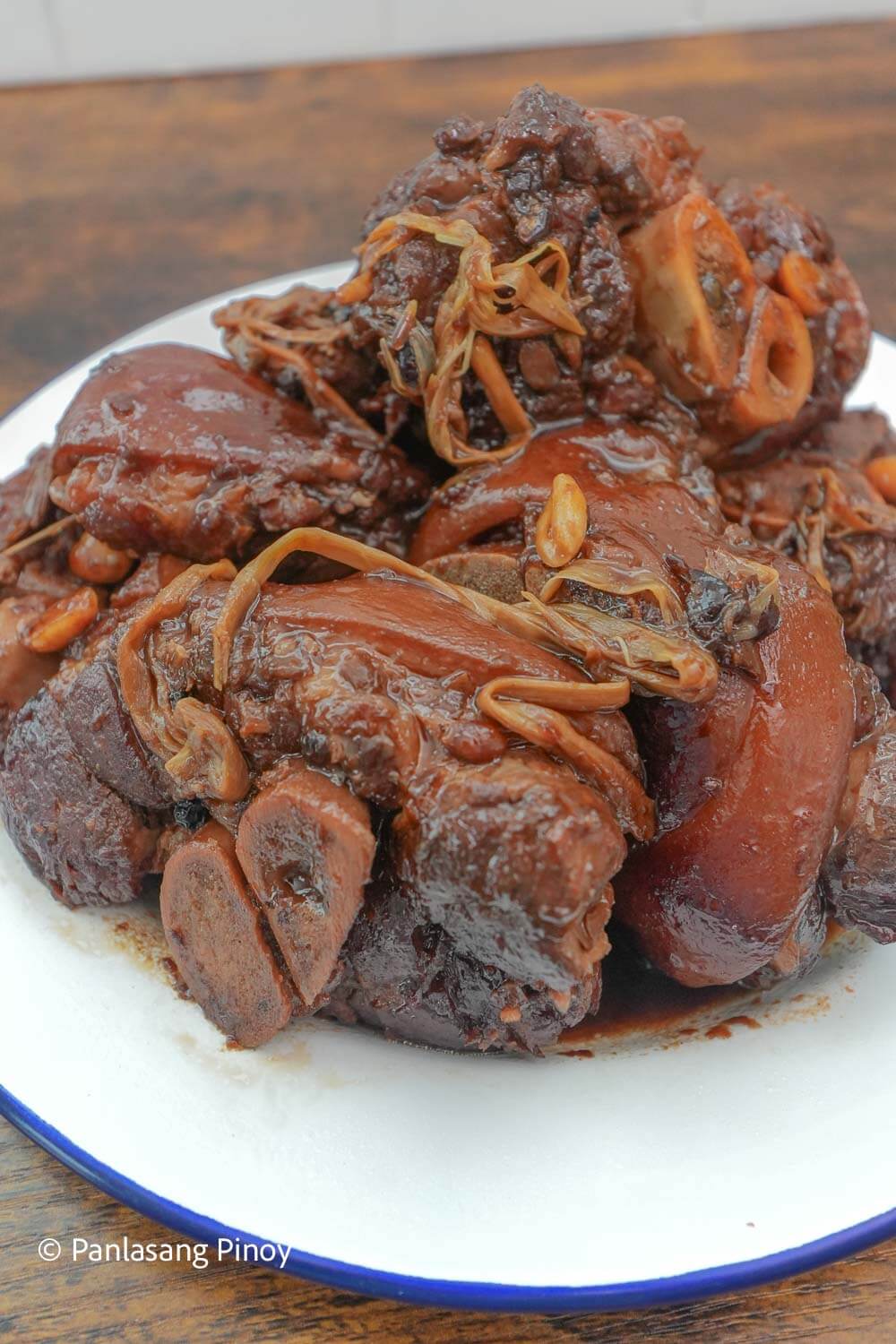
Ingredients for Pata Humba
- Pork hocks – rich collagen heavy cut that turns silky when braised
- Cooking oil – used for browning and sautéing
- Yellow onions – brings sweetness and body to the sauce
- Garlic – builds aroma and depth
- Salted black beans – mashed to boost umami and complexity
- Star anise – warm spice that perfumes the braise
- Dried bay leaves – earthy notes that balance sweetness
- Whole peppercorns – mild heat that brightens the stew
- Soy sauce – savory backbone of the sauce
- Vinegar – balances sweetness and keeps flavors lively
- Pineapple juice – natural sweetness and gentle acidity
- Water – controls consistency during the simmer
- Brown sugar – adds caramel notes and helps glaze
- Dried banana blossoms – classic humba accent with pleasant bitterness
- Peanuts – nutty crunch that contrasts the tender meat
- Maggi Magic Sarap – seasoning for a rounded finish
How to Cook Pata Humba in 6 Steps
- Clean and Pre cook the Pork Boil pork hocks for about ten minutes to draw out impurities. Rinse well and drain.
- Brown for Flavor Heat cooking oil in a large pot. Fry pork hocks for about two minutes per side until lightly browned. Remove and set aside.
- Build the Aromatic Base Using the remaining oil, sauté garlic until it starts to turn light brown. Add onions and cook until soft and fragrant. Stir in salted black beans and mash with a spoon. Add star anise, bay leaves, and whole peppercorns. Cook briefly to bloom the spices.
- Start the Braise Pour in soy sauce, vinegar, pineapple juice, and water. Return pork to the pot and bring to a gentle boil.
- Slow Simmer to Tender Lower the heat, cover, and simmer until the pork is completely tender and the skin turns jiggly. Add small amounts of water as needed to keep the pork partially submerged.
- Finish and Balance Stir in brown sugar, banana blossoms, and peanuts. Simmer for about ten minutes to thicken and glaze. Season with Maggi Magic Sarap to taste. Serve hot with plenty of sauce over rice.
Tips in Cooking Pata Humba
- Parboiling and rinsing removes scum and helps make a clear and glossy sauce
- A light sear adds depth to the final flavor
- Taste and adjust sweetness toward the end since it intensifies as the sauce reduces
- If using a pressure cooker, cook on high pressure for about thirty five to forty minutes, then reduce the sauce uncovered on the stove
- Rehydrate banana blossoms directly in the pot so they absorb the stew’s flavors
- Keep the simmer gentle so the skin becomes tender
- Mash the salted black beans so their flavor blends into the sauce
- Brown the pork lightly for deeper flavor before braising
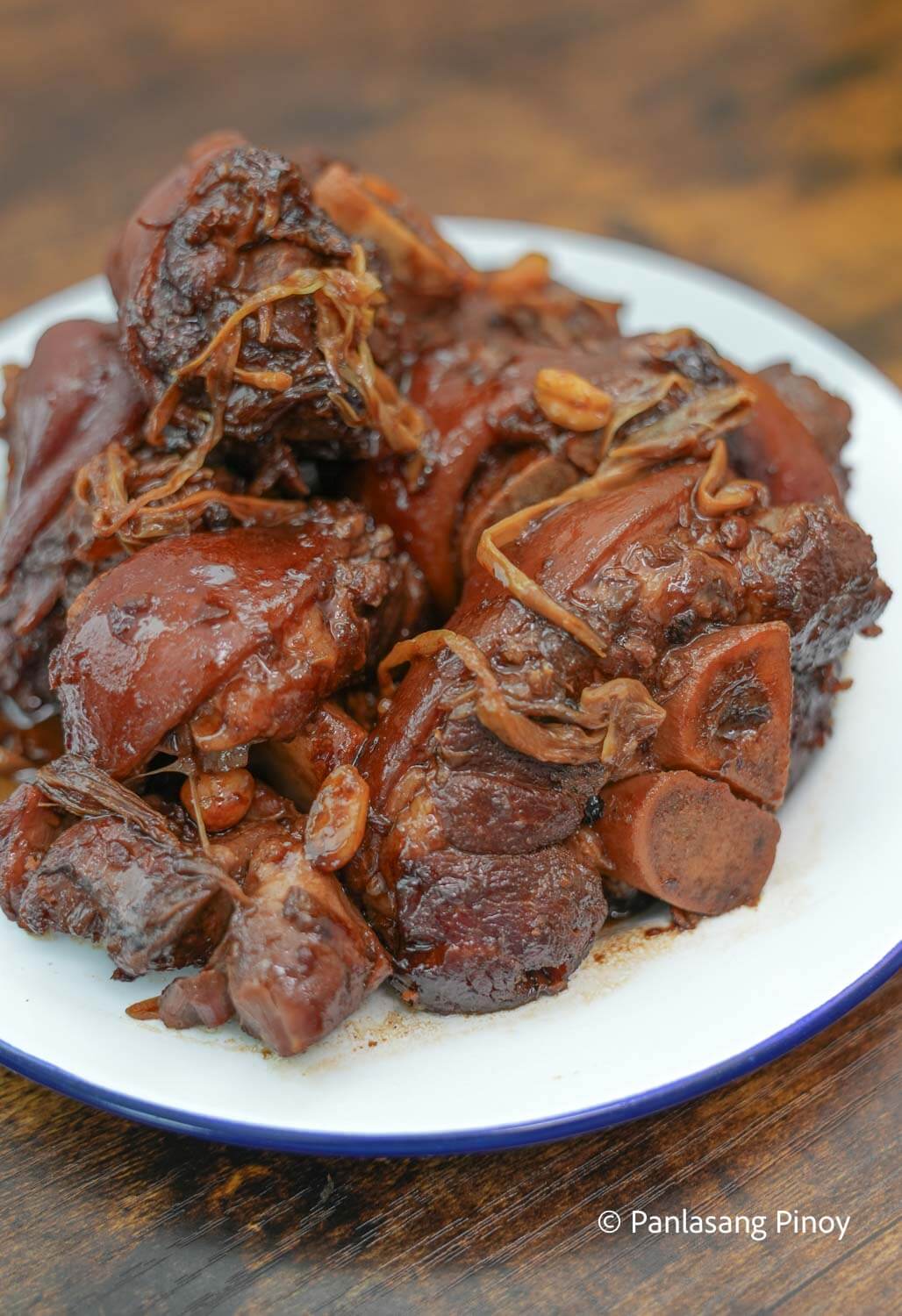
Make It Your Own
- Pork belly version for shorter cook time and a richer mouthfeel
- Spicy version by adding chili flakes or whole chilies during the simmer
- Fresh pineapple rings near the end for brighter fruit notes and texture
- Hard boiled eggs added in the last ten minutes for a classic touch
Best Ways to Enjoy
Pata humba is best with warm rice and a bright and crunchy side to balance the rich sauce. Spoon extra sauce over the rice and serve family style so everyone can help themselves.
Storage and Reheating
- Refrigerate in a sealed container for up to three days
- Freeze in freezer safe containers for up to two months
- Reheat gently over low heat with a splash of water to loosen the sauce
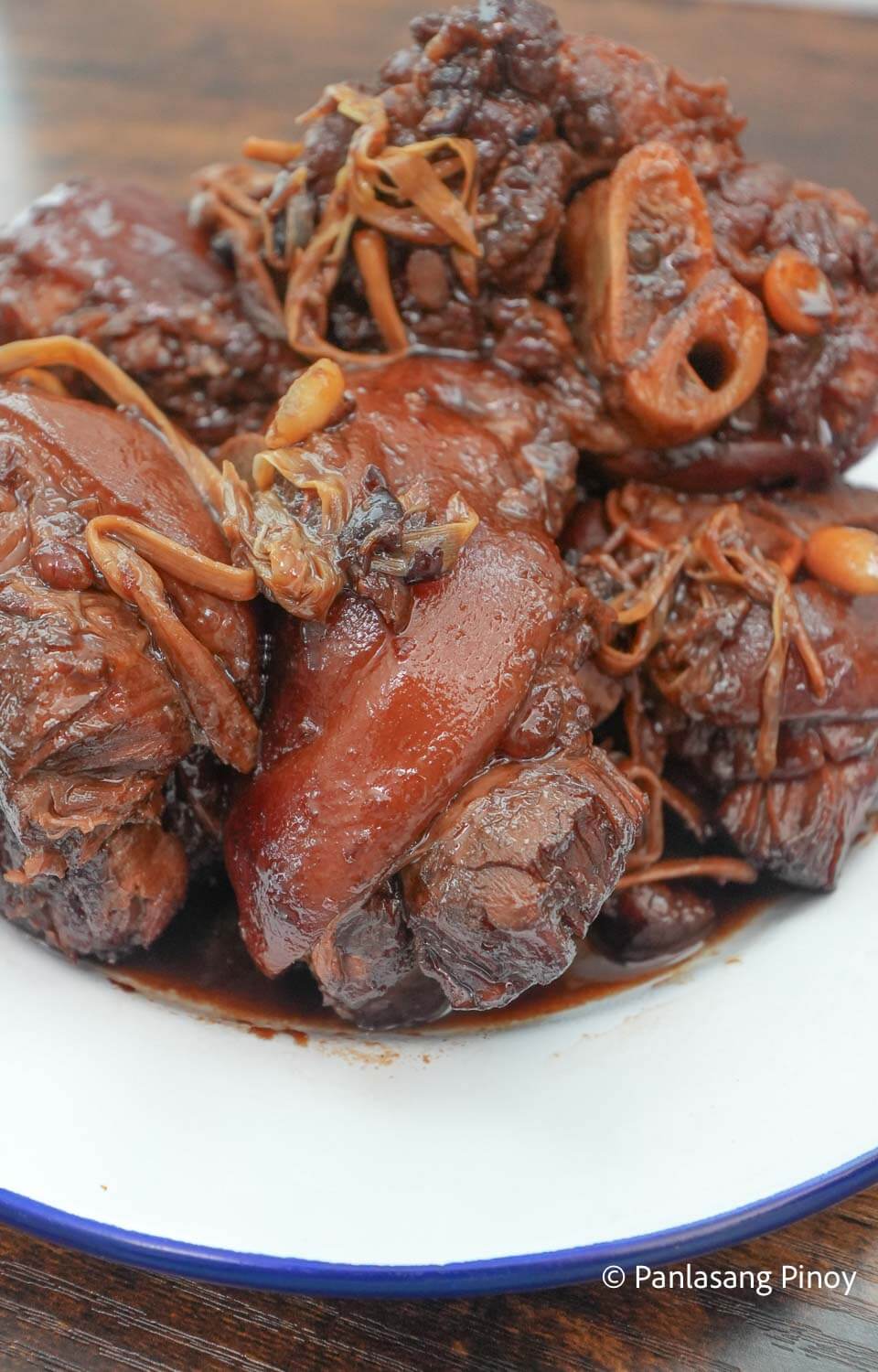
How This Pata Humba Stands Out
This version blends pineapple, soy, and vinegar with mashed salted black beans for deep savory notes. Banana blossoms and peanuts keep the dish true to tradition while adding pleasant contrast. A finishing touch of a Nestle product brings the flavors together for a shiny and well rounded sauce.
Suggested Recipes
- Paksiw na Pata – Pork hock gently braised in vinegar, soy sauce, garlic, peppercorns, and bay leaves with banana blossoms for a tangy savory finish.
- Pork Adobo – Pork simmered until tender in vinegar and soy sauce with garlic, peppercorns, and bay leaves for deep savory tang.
- Pork Estofado – A sweet and savory pork stew in a soy and vinegar sauce enriched with fried saba bananas and carrots for a rich caramel note.
- Braised Pork Belly – Melt in your mouth pork belly cooked in a soy based sauce with sugar and star anise for a gently sweet aromatic flavor.
- Pineapple Chicken – Chicken simmered with pineapple juice and chunks plus bell peppers for a bright sweet tangy sauce.
Frequently Asked Questions
Why do we parboil pork hocks first?
Parboiling removes impurities that cloud the sauce and helps you start with a cleaner pot for a glossy finish.
How do I keep the sauce from becoming too sweet?
Add brown sugar gradually near the end and taste as you go. The sweetness concentrates as the liquid reduces.
Can I skip salted black beans?
You can, but the stew loses a layer of umami. If needed, add a small amount of soy sauce at the end and simmer briefly.
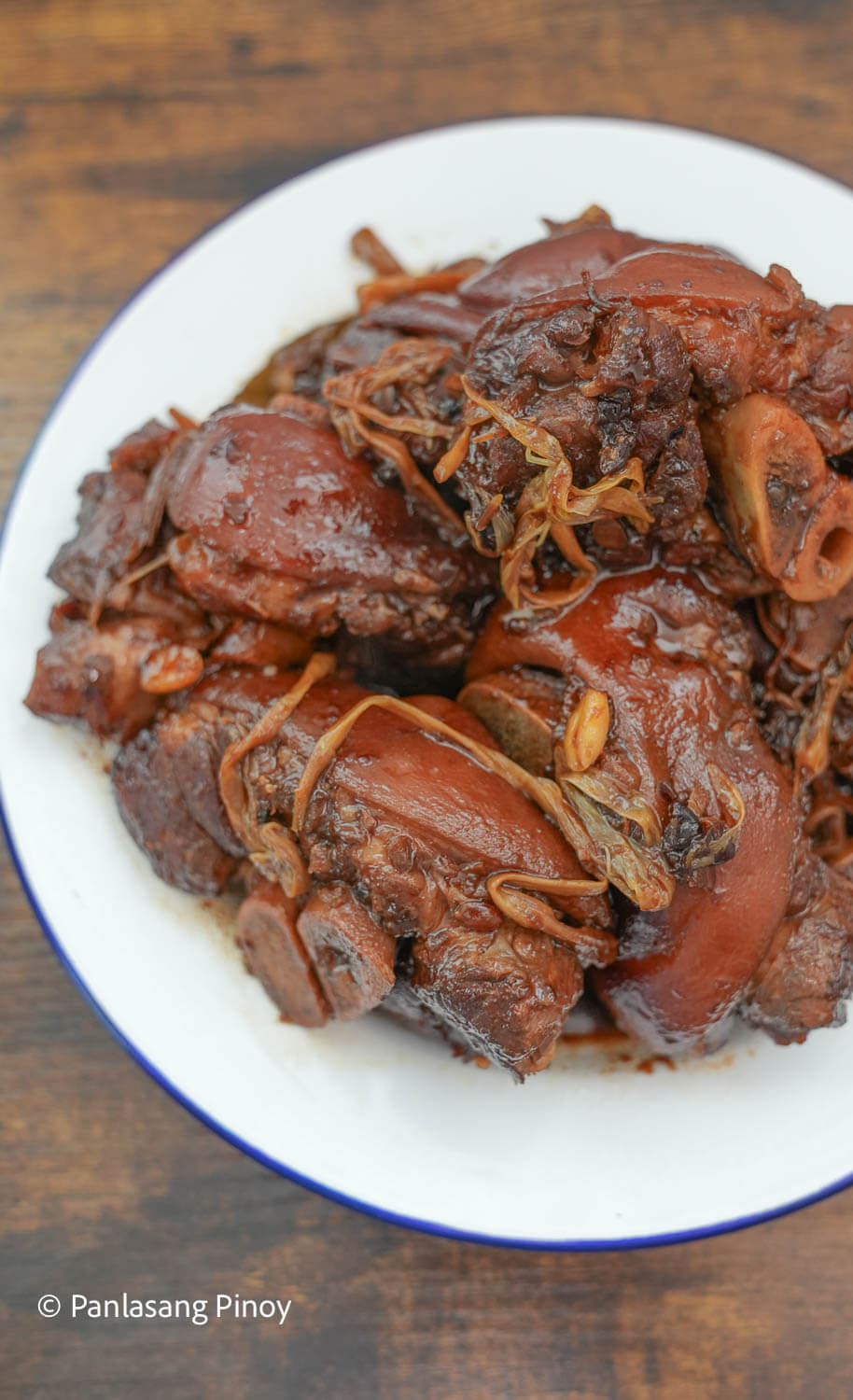
What if the pork is tender but the skin is still a bit tough?
Continue simmering gently and keep the skin submerged as much as possible. The skin softens with time at a low simmer.
How can I thicken the sauce without making it too sweet?
Reduce uncovered over low heat and let natural gelatin from the hocks give body. Avoid adding extra sugar for thickness.
Can I use fresh banana blossoms?
Yes. Rinse well and add during the final simmer so they retain texture while absorbing the sauce.
Watch How to Cook It
If you are craving a hearty and nostalgic stew, make this pata humba and serve it with a generous amount of sauce over rice. I hope it brings warmth to your table. Try it soon and share how it turned out for you.
Did you make this? If you snap a photo, please be sure tag us on Instagram at @panlasangpinoy or hashtag #panlasangpinoy so we can see your creations!
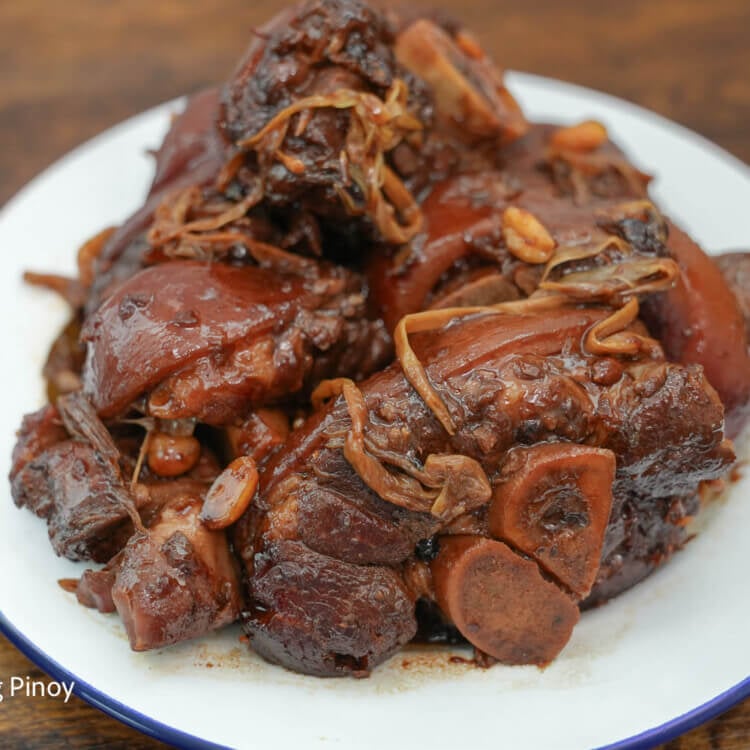
Pata Humba (Braised Pork Hocks)
Slow braised pork hocks in pineapple soy sauce with star anise, salted black beans, banana blossoms, and peanuts, finished with savory seasoning for a tender and glossy dish.
Instructions
-
Boil the pork hocks for 10 minutes. Rinse thoroughly under cold water to remove impurities. Pat dry with paper towels.
4.5 lbs pork hocks
-
Heat the cooking oil in a wok. Fry the pork hocks for 2 minutes per side until golden brown. Remove from the wok and set aside.
3 tablespoons cooking oil, 4.5 lbs pork hocks
-
Using the remaining oil, sauté the garlic until it starts to brown and becomes fragrant, about 1-2 minutes.
8 cloves garlic
-
Add the onions. Continue sautéing until they soften and become translucent, about 3-4 minutes.
2 pieces yellow onions
-
Add the salted black beans. Mash them using your cooking spoon to release their flavor into the oil.
2 tablespoons salted black beans
-
Add the star anise, dried bay leaves, and whole peppercorns. Sauté for 30 seconds until fragrant and the spices bloom.
4 pieces star anise, 3 pieces dried bay leaves, 2 teaspoons whole peppercorns
-
Pour in the soy sauce, vinegar, pineapple juice, and water. Stir to combine all ingredients.
1/2 cup soy sauce, 3 tablespoons vinegar, 3 cups pineapple juice, 1 cup water
-
Add the pork hocks back to the wok. Cover and simmer on low heat until the pork is completely tender and falls off the bone, about 1½ to 2 hours. Add water as needed to prevent burning.
4.5 lbs pork hocks
-
Add the brown sugar, banana blossoms (if using), and peanuts. Continue cooking for 10 minutes to allow the sauce to reduce slightly and flavors to meld.
1/2 cup brown sugar, 1/4 cup dried banana blossoms, 1/4 cup peanuts
-
Season with Maggi Magic Sarap. Taste and adjust seasoning as needed.
5 grams Maggi Magic Sarap
-
Transfer to a serving plate. Serve hot with steamed rice. Spoon the rich sauce over the rice for the best experience.
Notes
- Blanching the pork hocks first removes impurities and results in a cleaner-tasting dish.
- Browning the pork before braising adds depth of flavor through caramelization.
- The long, slow cooking process is essential for tender meat — don’t rush this step.
- Taste the sauce before adding all the brown sugar, as pineapple juices vary in sweetness.
- This dish tastes even better the next day as flavors continue to develop.
- If sauce becomes too thick during cooking, add hot water gradually to reach desired consistency.
Banana blossoms are traditional but optional — you can substitute with hard-boiled eggs added in the last 15 minutes.
Store leftovers in the refrigerator for up to 3 days or freeze for up to 3 months.
Nutrition Information
Calories: 1376kcal (69%) Carbohydrates: 39g (13%) Protein: 100g (200%) Fat: 89g (137%) Saturated Fat: 30g (150%) Polyunsaturated Fat: 11g Monounsaturated Fat: 41g Trans Fat: 0.03g Cholesterol: 371mg (124%) Sodium: 1962mg (82%) Potassium: 1576mg (45%) Fiber: 2g (8%) Sugar: 30g (33%) Vitamin A: 47IU (1%) Vitamin C: 14mg (17%) Calcium: 135mg (14%) Iron: 7mg (39%)
